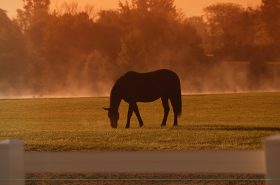Do you have what it takes to become your horse’s hoof care provider?
Once upon a time, my answer to this question would have been a definitive no. After all, how could a petite woman with limited hoof knowledge possibly trim a horse’s feet?
However, I’ve since learned that I’m capable of far more than I once believed—hoof care included. I’m proud to say that I’ve now managed my horses’ hoof care for approximately eleven years.
Of course, it wasn’t a simple decision. I didn’t just pick up a pair of nippers and decide, “I’m going to trim my horse today!” It was a much longer and more involved process than that. In fact, I came to the conclusion that I should start trimming when I couldn’t find any other barefoot trimmers available in my area.
Though I wasn’t aware at first, my hoof care education had actually begun years earlier, by watching my husband trim (he attended farrier school once upon a time). But as I began this new journey, I asked him lots of questions, read anything I could find on barefoot hoof care, watched videos, and then took it very slowly, always maintaining the idea of “less is more”.
These days, I love having a trimmer I can depend on, and I feel like this trimmer (aka me!) has become very attuned to each of my horse’s hoof care needs.
With that said, I would like to encourage anyone who has an interest in trimming their own horses to go for it. Barefoot trimming differs from a traditional farrier trim, but it isn’t rocket science and physical stamina can definitely be built up. Here are a few tips I have for anyone who would like to go this route:
- Read as much information (books, websites, online forums, etc.) as you can before ever picking up a pair of nippers;
- Make sure you have a solid understanding of hoof anatomy and internal structures;
- Learn from those with experience by asking to watch them trim or attending a clinic;
- Invest in the right tools: hoof stand, nippers, rasp, and a hoof knife at the very least;
- Go slow, and always keep in mind that you won’t hurt a horse by trimming too little, but you can easily hurt them if you trim too much;
- Ask for help if and when you need it.
If you’re thinking of learning to trim or already do trim your horses, feel free to share your thoughts in the comments below!
**
Casie Bazay is a freelance and young adult writer, as well as an owner/barefoot trimmer and certified equine acupressure practitioner. She hosts the blog, The Naturally Healthy Horse, where she regularly shares information on barefoot, equine nutrition, and holistic horse health. Once an avid barrel racer, Casie now enjoys just giving back to the horses who have given her so much. Follow Casie at www.casiebazay.com.



